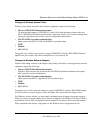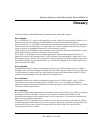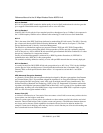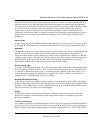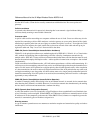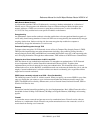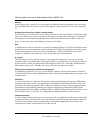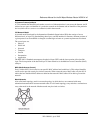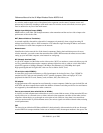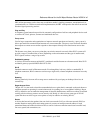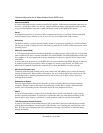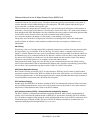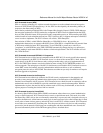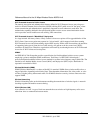
Reference Manual for the 54 Mbps Wireless Router WGR614 v6
-8 Glossary
202-10099-01, April 2005
In a wireless mesh example, each of the spheres below represent a mesh router. Corporate servers and
printers may be shared by attaching to each mesh router. For wireless access to the mesh, an access point
must be attached to any one of the mesh routers.
Multiple Input Multiple Output (MIMO)
MIMO refers to radio links with multiple antennas at the transmitter and the receiver side to improve the
performance of the wireless link.
NAT (Network Address Translation)
A network capability that enables a houseful of computers to dynamically share a single incoming IP
address from a dial-up, cable or xDSL connection. NAT takes the single incoming IP address and creates
new IP address for each client computer on the network.
Network name
Identifies the wireless network for all the shared components. During the installation process for most
wireless networks, you need to enter the network name or SSID. Different network names are used when
setting up your individual computer, wired network or workgroup.
NIC (Network Interface Card)
A type of PC adapter card that either works without wires (Wi-Fi) or attaches to a network cable to provide
two-way communication between the computer and network devices such as a hub or switch. Most office
wired NICs operate at 10 Mbps (Ethernet), 100 Mbps (Fast Ethernet) or 10/100 Mbps dual speed.
High-speed Gigabit and 10 Gigabit NIC cards are also available. See PC Card.
PC card (also called PCMCIA)
A removable, credit-card-sized memory or I/O (input/output) device that fits into a Type 2 PCMCIA
standard slot, PC Cards are used primarily in PCs, portable computers, PDAs and laptops. PC Card
peripherals include Wi-Fi cards, memory cards, modems, NICs, hard drives, etc.
PCI adapter
A high-performance I/O computer bus used internally on most computers. Other bus types include ISA and
AGP. PCIs and other computer buses enable the addition of internal cards that provide services and features
not supported by the motherboard or other connectors.
Peer-to-peer network (also called Ad-Hoc in WLANs)
A wireless or wired computer network that has no server or central hub or router. All the networked PCs are
equally able to act as a network server or client, and each client computer can talk to all the other wireless
computers without having to go through an access point or hub. However, since there is no central base
station to monitor traffic or provide Internet access, the various signals can collide with each other, reducing
overall performance.
PHY
The lowest layer within the OSI Network Model. It deals primarily with transmission of the raw bit stream
over the PHYsical transport medium. In the case of wireless LANs, the transport medium is free space. The



